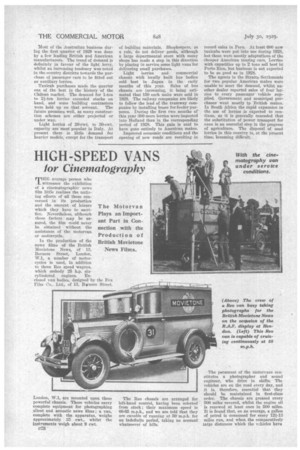Sales Chances Abroad
Page 49

Page 50

If you've noticed an error in this article please click here to report it so we can fix it.
A Survey of the Commercial-motor Markets in the More Important Consuming Countries. An Increase in the Sales of Commercial Vehicles.
WITH but very few exceptions, such as Cuba and Mexico, increased sales of lorries and buses, during the
• first quarter of 1929, are reported from the various countries of the world.
The most prominent development in Austria this year is the expansion of bus services. About 200 new state lines and 650 private lines are expected to be established by the end of the summer, whilst the increase in cross-country freight traffic by road is expected to amount to 50 new services. Concessions are granted only on condition that buses of borne make be used, and it is probably because of this that almost all motor manufacturers, with the exception of the Steyr and Austro-Daimler concerns, are concentrating entirely upon the production of commercial vehicles.
Although light models dominate the lorry and bus market in Belgium, a feeling has developed that vehicles intended for 30-cwt. to 3-ton loads can be sold successfully. Two American makes covering these categories have just been introduced, and will be backed up by a vigorous sales campaign.
Lorry sales in Denmark were satia
factory during the first quarter of 1929. Low-priced units of 10-cwt. to 30-cwt. capacity are the most popular, and American makes accounted for about 90 per cent. of the total sales. A threewheeled vehicle with a capacity of 400500 kilos. has recently been introduced on the market. In Germany sales of commercial vehicles during the past quarter were 'somewhat affected by price-cutting which was undertaken to clear out old models.
Motor Lorries in Greece.
Heavy shipments of lorries were expected in Greece during April, and dealers are aiming at developing the provincial territories as an outlet for sales during the summer months. Bus development in Norway continues to be promising, or the nature of the country favours ihis foem ' of transportation. Almost so soon as new roads are opened, bus lines are organized, and these serve the country better than the railways do, because of the many isolated communities. The lorry market is mainly in the hands of American makers. The 20-cwt. and 30-cwt. models are preferred as the more practical, and they better meet the severe regulations against heavyvehicles.
Heavy-duty buses and lorries are gaining in popularity in Poland, experience having proved that lightweight vehicles can hardly do the work required of them under existing conditions of operation.
During last January 959 new lorries were registered in Spain, 520 being divided among the two leading American makes. Demand for the larger models is increasing. The same may be said with regard to buses, the trend being for the steady extension of bus lines to supplement railway transportation. The demand for lorries and bases continued active in SWeden, during the first quarter of 1929. As in 1928, vehicles having a capacity of two tons or less were in the greatest demand in the previously mentioned country.
Sales of lorries in Venezuela, during the early part of the year, remained at a comparatively high level, and better business is anticipated because of the good coffee crop. Trade is best in the towns of the interior as well as along the great Trans-Andean Highway. Most of the Australian business during the first quarter of 1929 was done by a few leading British and American manufacturers. The trend of demand is definitely in favour of the light lorry, whilst an increasing tendency was noted in the country districts towards the purchase of "passenger cars to he fitted out as auxiliary lorries.
Taxicab purchases made the quarter one of the best in the history of the Chilean market. The demand for 1-ton to 21-ton lorries exceeded stocks on band, and some building contractors
were held up on that account. The fixture promises well, as many construction schemes are either projected or Under way:
Light lorries of 20-ewt, to 30-cwt. capacity are'most popular in Italy. At present there is little demand for heavier models, except for the transport of building materials. Shopkeepers; as a rule, do not deliver goods, although a large departmental store with many shops has made a step in this direction by placing in service some light vans for delivering small purchases.
Light lorries and commercial chassis with locally built bus bodies sold best in Japan in the early months of this year. Sales of bus chassis are increasing, it being estimated that 150 such units were sold in 1928. The railway companies are likely to follow the lead of the tramway companies by installing buses for feeder purposes. During the first two months of this year 800 more lorries were imported into Holland than in the corresponding period of 1928. This gain is said to have gone entirely to American makes.
Improved economic conditions and the opening of new roads are resulting in record sales in Peru. At least BOO new taxicabs were put into use during 1928, but these were mostly adaptations of the cheaper American touring cars. Lorries with capacities up to 2 tons sell best in Porto Rico, but business is not expected to be so good as in 1928.
The agents in the Straits Settlements for two popular American makes were unable to meet the demand, whilst another dealer reported sales of four lorries to every passenger vehicle supplied. Government and municipal purchases went mostly to British makes. In South Africa the rapid expansion in the use of lorries is expected to continue, as it is generally conceded that the substitution of power transport for oxen is an essential step in the progress of agriculture. The disposal of used lorries in this country is, at the ptesent time, becoming difficult.












































































































